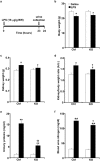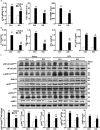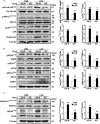Protein tyrosine phosphatase Shp2 deficiency in podocytes attenuates lipopolysaccharide-induced proteinuria
- PMID: 28352079
- PMCID: PMC5428720
- DOI: 10.1038/s41598-017-00564-3
Protein tyrosine phosphatase Shp2 deficiency in podocytes attenuates lipopolysaccharide-induced proteinuria
Abstract
Podocytes are specialized epithelial cells that play a significant role in maintaining the integrity of the glomerular filtration barrier and preventing urinary protein leakage. We investigated the contribution of protein tyrosine phosphatase Shp2 to lipopolysaccharide (LPS)-induced renal injury. We report increased Shp2 expression in murine kidneys and cultured podocytes following an LPS challenge. To determine the role of podocyte Shp2 in vivo, we generated podocyte-specific Shp2 knockout (pod-Shp2 KO) mice. Following administration of LPS, pod-Shp2 KO mice exhibited lower proteinuria and blood urea nitrogen concentrations than controls indicative of preserved filter integrity. In addition, renal mRNA and serum concentrations of inflammatory cytokines IL-1β, TNFα, INFγ and IL-12 p70 were significantly decreased in LPS-treated knockout mice compared with controls. Moreover, the protective effects of podocyte Shp2 deficiency were associated with decreased LPS-induced NF-κB and MAPK activation, nephrin phosphorylation and attenuated endoplasmic reticulum stress. These effects were recapitulated in differentiated E11 murine podocytes with lentiviral-mediated Shp2 knockdown. Furthermore, Shp2 deficient podocytes displayed reduced LPS-induced migration in a wound healing assay. These findings identify Shp2 in podocytes as a significant contributor to the signaling events following LPS challenge and suggest that inhibition of Shp2 in podocytes may present a potential therapeutic target for podocytopathies.
Conflict of interest statement
The authors declare that they have no competing interests.
Figures







Similar articles
-
Protein tyrosine phosphatase 1B deficiency in podocytes mitigates hyperglycemia-induced renal injury.Metabolism. 2017 Nov;76:56-69. doi: 10.1016/j.metabol.2017.07.009. Epub 2017 Aug 8. Metabolism. 2017. PMID: 28987240 Free PMC article.
-
Podocyte-specific soluble epoxide hydrolase deficiency in mice attenuates acute kidney injury.FEBS J. 2017 Jul;284(13):1970-1986. doi: 10.1111/febs.14100. Epub 2017 May 29. FEBS J. 2017. PMID: 28485854 Free PMC article.
-
Shp2 Associates with and Enhances Nephrin Tyrosine Phosphorylation and Is Necessary for Foot Process Spreading in Mouse Models of Podocyte Injury.Mol Cell Biol. 2015 Dec 7;36(4):596-614. doi: 10.1128/MCB.00956-15. Print 2016 Feb 15. Mol Cell Biol. 2015. PMID: 26644409 Free PMC article.
-
Deficiency of the Src homology phosphatase 2 in podocytes is associated with renoprotective effects in mice under hyperglycemia.Cell Mol Life Sci. 2022 Sep 14;79(10):516. doi: 10.1007/s00018-022-04517-6. Cell Mol Life Sci. 2022. PMID: 36102977 Free PMC article.
-
Loss of the podocyte glucocorticoid receptor exacerbates proteinuria after injury.Sci Rep. 2017 Aug 29;7(1):9833. doi: 10.1038/s41598-017-10490-z. Sci Rep. 2017. PMID: 28852159 Free PMC article.
Cited by
-
Podocyte specific deletion of PKM2 ameliorates LPS-induced podocyte injury through beta-catenin.Cell Commun Signal. 2022 May 30;20(1):76. doi: 10.1186/s12964-022-00884-6. Cell Commun Signal. 2022. PMID: 35637461 Free PMC article.
-
Adiponectin receptor agonist AdipoRon ameliorates renal inflammation in diet-induced obese mice and endotoxin-treated human glomeruli ex vivo.Diabetologia. 2021 Aug;64(8):1866-1879. doi: 10.1007/s00125-021-05473-9. Epub 2021 May 14. Diabetologia. 2021. PMID: 33987714 Free PMC article.
-
SHP2 inhibitor PHPS1 ameliorates acute kidney injury by Erk1/2-STAT3 signaling in a combined murine hemorrhage followed by septic challenge model.Mol Med. 2020 Sep 21;26(1):89. doi: 10.1186/s10020-020-00210-1. Mol Med. 2020. PMID: 32957908 Free PMC article.
-
Chow fed UC Davis strain female Lepr fatty Zucker rats exhibit mild glucose intolerance, hypertriglyceridemia, and increased urine volume, all reduced by a Brown Norway strain chromosome 1 congenic donor region.PLoS One. 2017 Dec 6;12(12):e0188175. doi: 10.1371/journal.pone.0188175. eCollection 2017. PLoS One. 2017. PMID: 29211750 Free PMC article.
-
Protein tyrosine phosphatase 1B deficiency in podocytes mitigates hyperglycemia-induced renal injury.Metabolism. 2017 Nov;76:56-69. doi: 10.1016/j.metabol.2017.07.009. Epub 2017 Aug 8. Metabolism. 2017. PMID: 28987240 Free PMC article.
References
Publication types
MeSH terms
Substances
Grants and funding
LinkOut - more resources
Full Text Sources
Other Literature Sources
Molecular Biology Databases
Research Materials

